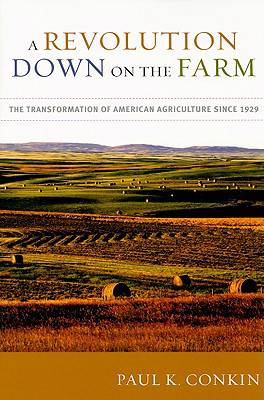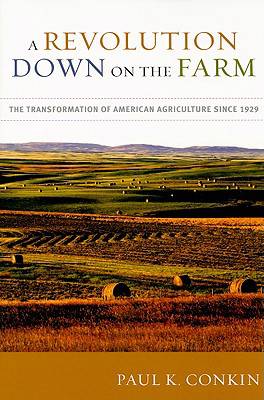
- Retrait gratuit dans votre magasin Club
- 7.000.000 titres dans notre catalogue
- Payer en toute sécurité
- Toujours un magasin près de chez vous
- Retrait gratuit dans votre magasin Club
- 7.000.000 titres dans notre catalogue
- Payer en toute sécurité
- Toujours un magasin près de chez vous
A Revolution Down on the Farm
The Transformation of American Agriculture Since 1929
Paul K ConkinDescription
At a time when food is becoming increasingly scarce in many parts of the world and food prices are skyrocketing, no industry is more important than agriculture. Humans have been farming for thousands of years, and yet agriculture has undergone more fundamental changes in the past 80 years than in the previous several centuries. In 1900, 30 million American farmers tilled the soil or tended livestock; today there are fewer than 4.5 million farmers who feed a population four times larger than it was at the beginning of the century. Fifty years ago, the planet could not have sustained a population of 6.5 billion; now, commercial and industrial agriculture ensure that millions will not die from starvation. Farmers are able to feed an exponentially growing planet because the greatest industrial revolution in history has occurred in agriculture since 1929, with U.S. farmers leading the way. Productivity on American farms has increased tenfold, even as most small farmers and tenants have been forced to find other work. Today, only 300,000 farms produce approximately ninety percent of the total output, and overproduction, largely subsidized by government programs and policies, has become the hallmark of modern agriculture. A Revolution Down on the Farm: The Transformation of American Agriculture since 1929 charts the profound changes in farming that have occurred during author Paul K. Conkin's lifetime. His personal experiences growing up on a small Tennessee farm complement compelling statistical data as he explores America's vast agricultural transformation and considers its social, political, and economic consequences. He examines the history of American agriculture, showing how New Deal innovations evolved into convoluted commodity programs following World War II. Conkin assesses the skills, new technologies, and government policies that helped transform farming in America and suggests how new legislation might affect farming in decades to come. Although the increased production and mechanization of farming has been an economic success story for Americans, the costs are becoming increasingly apparent. Small farmers are put out of business when they cannot compete with giant, non-diversified corporate farms. Caged chickens and hogs in factory-like facilities or confined dairy cattle require massive amounts of chemicals and hormones ultimately ingested by consumers. Fertilizers, new organic chemicals, manure disposal, and genetically modified seeds have introduced environmental problems that are still being discovered. A Revolution Down on the Farm concludes with an evaluation of farming in the twenty-first century and a distinctive meditation on alternatives to our present large scale, mechanized, subsidized, and fossil fuel and chemically dependent system.
Spécifications
Parties prenantes
- Auteur(s) :
- Editeur:
Contenu
- Nombre de pages :
- 240
- Langue:
- Anglais
Caractéristiques
- EAN:
- 9780813192420
- Date de parution :
- 01-07-09
- Format:
- Livre broché
- Format numérique:
- Trade paperback (VS)
- Dimensions :
- 162 mm x 229 mm
- Poids :
- 367 g







